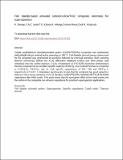| dc.contributor.author | Sirengo, Keith | |
| dc.contributor.author | Jande, Yusufu | |
| dc.contributor.author | Kibona, Talam | |
| dc.contributor.author | Hilonga, Askwar | |
| dc.contributor.author | Muiva, Cosmas | |
| dc.contributor.author | King'ondu, Cecil | |
| dc.date.accessioned | 2020-03-31T07:49:53Z | |
| dc.date.available | 2020-03-31T07:49:53Z | |
| dc.date.issued | 2019-06-15 | |
| dc.identifier.uri | https://doi.org/10.1016/j.matchemphys.2019.04.059 | |
| dc.identifier.uri | https://dspace.nm-aist.ac.tz/handle/20.500.12479/694 | |
| dc.description | This research article published by Elsevier B.V., 2019 | en_US |
| dc.description.abstract | Cobalt oxide/titanium dioxide/activated carbon (Co3O4/TiO2/Ac) composite was synthesized using simple sol-gel method before annealing at 300 °C. Fish bladder derived porous carbon used for the composite was synthesized by pyrolysis followed by chemical activation. Both scanning electron microscopy (SEM) and X-ray diffraction displayed Co3O4 and TiO2 phases well embedded onto the carbon matrices. Cyclic voltammetry in 6 M KOH electrolyte demonstrated that the composite has an excellent specific capacity of 946 Fg-1 for Co3O4/TiO2/Ac as compared to Co3O4/Ac, TiO2/Ac, and Ac with specific capacitances of 845, 340, and 308 F g−1, respectively at 5 mVs−1. Impedance spectroscopy reveals that the composite has good capacitive behavior with a series resistance of 0.6 Ω. Besides, Co3O4/TiO2/Ac maintains 89.7% of the initial capacitance after 2000 cycles. This study shows that the synergistic effect of the metal oxides and the carbon in the composite can enhance capacitance for practical supercapacitor applications. | en_US |
| dc.language.iso | en | en_US |
| dc.publisher | Elsevier B.V. | en_US |
| dc.subject | Fish bladder activated carbon | en_US |
| dc.subject | Specific capacitance | en_US |
| dc.subject | Cobalt oxide | en_US |
| dc.subject | Titanium dioxide | en_US |
| dc.title | Fish bladder-based activated carbon/Co3O4/TiO2 composite electrodes for supercapacitors | en_US |
| dc.type | Article | en_US |

